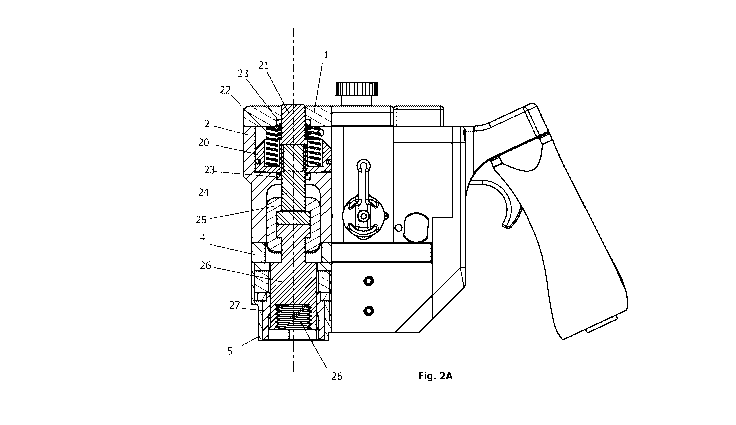Une partie des informations de ce site Web a été fournie par des sources externes. Le gouvernement du Canada n'assume aucune responsabilité concernant la précision, l'actualité ou la fiabilité des informations fournies par les sources externes. Les utilisateurs qui désirent employer cette information devraient consulter directement la source des informations. Le contenu fourni par les sources externes n'est pas assujetti aux exigences sur les langues officielles, la protection des renseignements personnels et l'accessibilité.
L'apparition de différences dans le texte et l'image des Revendications et de l'Abrégé dépend du moment auquel le document est publié. Les textes des Revendications et de l'Abrégé sont affichés :
| (12) Demande de brevet: | (11) CA 3102081 |
|---|---|
| (54) Titre français: | OUTIL PERMETTANT DE SERRER UN ECROU SUR UN BOULON POUR FORMER UNE LIAISON FIXE |
| (54) Titre anglais: | TOOL FOR TIGHTENING NUT ON A BOLT TO FORM A FIXED CONNECTION |
| Statut: | Demande conforme |
| (51) Classification internationale des brevets (CIB): |
|
|---|---|
| (72) Inventeurs : |
|
| (73) Titulaires : |
|
| (71) Demandeurs : |
|
| (74) Agent: | KIRBY EADES GALE BAKER |
| (74) Co-agent: | |
| (45) Délivré: | |
| (86) Date de dépôt PCT: | 2019-06-20 |
| (87) Mise à la disponibilité du public: | 2019-12-26 |
| Licence disponible: | S.O. |
| Cédé au domaine public: | S.O. |
| (25) Langue des documents déposés: | Anglais |
| Traité de coopération en matière de brevets (PCT): | Oui |
|---|---|
| (86) Numéro de la demande PCT: | PCT/NO2019/050131 |
| (87) Numéro de publication internationale PCT: | NO2019050131 |
| (85) Entrée nationale: | 2020-11-30 |
| (30) Données de priorité de la demande: | ||||||
|---|---|---|---|---|---|---|
|
La présente invention se rapporte à un outil qui permet de serrer un écrou sur un boulon pour former une liaison fixe, et qui est constitué d'une pompe hydraulique à entraînement pneumatique transférant une pression d'huile à un vérin hydraulique avec un piston relié à un arbre qui, au moyen d'un moteur à entraînement pneumatique (90'), est amené à se visser sur les filets du boulon où l'écrou est relié à un second moteur à entraînement pneumatique (91') distinct qui visse l'écrou sur ledit boulon alors que le boulon est étiré.
A Tool for tightening a nut on a bolt to form a fixed connection, consisting of an air-driven hydraulic pump which transfers oil pressure to a hydraulic cylinder with a piston connected to a shaft which by means of an air-driven motor (90') is caused to screw on the threads of the bolt where the nut is connected to a second separate 5 air-driven motor (91') that screws the nut on the said bolt as the bolt is stretched.
Note : Les revendications sont présentées dans la langue officielle dans laquelle elles ont été soumises.
Note : Les descriptions sont présentées dans la langue officielle dans laquelle elles ont été soumises.

2024-08-01 : Dans le cadre de la transition vers les Brevets de nouvelle génération (BNG), la base de données sur les brevets canadiens (BDBC) contient désormais un Historique d'événement plus détaillé, qui reproduit le Journal des événements de notre nouvelle solution interne.
Veuillez noter que les événements débutant par « Inactive : » se réfèrent à des événements qui ne sont plus utilisés dans notre nouvelle solution interne.
Pour une meilleure compréhension de l'état de la demande ou brevet qui figure sur cette page, la rubrique Mise en garde , et les descriptions de Brevet , Historique d'événement , Taxes périodiques et Historique des paiements devraient être consultées.
| Description | Date |
|---|---|
| Inactive : Lettre officielle | 2024-03-28 |
| Exigences quant à la conformité - jugées remplies | 2023-06-28 |
| Paiement d'une taxe pour le maintien en état jugé conforme | 2023-06-28 |
| Représentant commun nommé | 2021-11-13 |
| Inactive : Page couverture publiée | 2021-01-06 |
| Lettre envoyée | 2020-12-22 |
| Exigences applicables à la revendication de priorité - jugée conforme | 2020-12-14 |
| Demande reçue - PCT | 2020-12-14 |
| Inactive : CIB en 1re position | 2020-12-14 |
| Inactive : CIB attribuée | 2020-12-14 |
| Demande de priorité reçue | 2020-12-14 |
| Déclaration du statut de petite entité jugée conforme | 2020-11-30 |
| Exigences pour l'entrée dans la phase nationale - jugée conforme | 2020-11-30 |
| Demande publiée (accessible au public) | 2019-12-26 |
Il n'y a pas d'historique d'abandonnement
Le dernier paiement a été reçu le 2023-06-28
Avis : Si le paiement en totalité n'a pas été reçu au plus tard à la date indiquée, une taxe supplémentaire peut être imposée, soit une des taxes suivantes :
Les taxes sur les brevets sont ajustées au 1er janvier de chaque année. Les montants ci-dessus sont les montants actuels s'ils sont reçus au plus tard le 31 décembre de l'année en cours.
Veuillez vous référer à la page web des
taxes sur les brevets
de l'OPIC pour voir tous les montants actuels des taxes.
| Type de taxes | Anniversaire | Échéance | Date payée |
|---|---|---|---|
| Taxe nationale de base - petite | 2020-11-30 | 2020-11-30 | |
| TM (demande, 2e anniv.) - petite | 02 | 2021-06-21 | 2021-06-16 |
| TM (demande, 3e anniv.) - petite | 03 | 2022-06-20 | 2022-06-17 |
| TM (demande, 4e anniv.) - petite | 04 | 2023-06-20 | 2023-06-28 |
| Surtaxe (para. 27.1(2) de la Loi) | 2023-06-28 | 2023-06-28 |
Les titulaires actuels et antérieures au dossier sont affichés en ordre alphabétique.
| Titulaires actuels au dossier |
|---|
| PATENTEC QUICKDRIVE AS |
| Titulaires antérieures au dossier |
|---|
| HILBERG INGE KAROLIUSSEN |